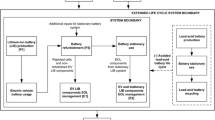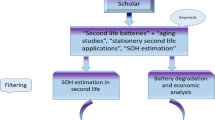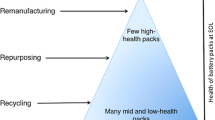Abstract
Purpose
Nowadays, the electric vehicle is one of the most promising alternatives for sustainable transportation. However, the battery, which is one of the most important components, is the main contributor to environmental impact and faces recycling issues. In order to reduce the carbon footprint and to minimize the overall recycling processes, this paper introduces the concept of re-use of electric vehicle batteries, analyzing some possible second-life applications.
Methods
First, the boundaries of the life cycle assessment of an electric vehicle are defined, considering the use of the battery in a second-life application. To perform the study, we present eight different scenarios for the second-life application. For each case, the energy, the efficiency, and the lifetime of the battery are calculated. Additionally, and based on the global warming potential, the environmental impact of the electric vehicle and its battery on a second-life application is determined for each scenario. Finally, an environmentally focused discussion on battery electrodes and research trends is presented.
Results and discussion
For the selected scenarios, the second life of the battery varies from 8 to 20 years depending on the application and the requirements. It has been observed that the batteries connected to the electricity grid for energy arbitrage storage have the highest impact per provided kilowatt hour. On the contrary, the environmental benefit comes from applications working with renewable energy sources and presenting a longer lifetime. We pointed out that a correlation between cycling conditions and degradation mechanisms of the electrode materials is compulsory for proper use of the electric vehicle battery in a second-life application.
Conclusions
To limit the environmental impact, batteries should be associated with renewable energy sources in stationary applications. However, it is more profitable to re-use Li-ion batteries than to use new lead-acid batteries. Although many batteries applied for electric vehicles use graphite-based anodes, the latter may not be the most suitable for the second-life application. A better understanding of Li-ion battery degradation during the second-life application is required for the different existing chemistries.





Similar content being viewed by others
References
4r-energy (2013) http://www.4r-energy.com/en/company/. Accessed 13 Feb 2014
Agubra V, Fergus J (2013) Lithium ion battery anode aging mechanisms. Mater (Basel) 6:1310–1325
Andrew B (2009) Performance, charging and second use considerations for lithium batteries for plug-in electric vehicles. Electr Storage Assoc Meet Sess Transp Grid
Armand M, Tarascon J-M (2008) Building better batteries. Nature 451:652–657
Bloom I, Jones SA, Battaglia VS et al (2003) Effect of cathode composition on capacity fade, impedance rise and power fade in high-power, lithium-ion cells. J Power Sources 124:538–550
Bradley TH, Frank AA (2009) Design, demonstrations and sustainability impact assessments for plug-in hybrid electric vehicles. Renew Sustain Energy Rev 13:115–128
Campanari S, Manzolini G, Garcia de la Iglesia F (2009) Energy analysis of electric vehicles using batteries or fuel cells through well-to-wheel driving cycle simulations. J Power Sources 186:464–477
Casals LC, García BA (2014) A review of the complexities of applying second life electric car batteries on energy businesses. Energy Syst. Conf.
Casals LC, Benítez MG, Amante García B (2014) A cost analysis of electric vehicle battery second life businesses. XVIII Int Congr Proj Manag Eng Alcañiz, 0946–0958
Chen CH, Liu J, Stoll ME et al (2004) Aluminum-doped lithium nickel cobalt oxide electrodes for high-power lithium-ion batteries. J Power Sources 128:278–285
Ciccioni P, Landi D, Alessandro Morbidoni, Germani M (2012) Feasibility analysis of second life applications for li-ion cells used in electric powertrain using environmental indicators. 2nd IEEE ENERGYCON Conf. Exhib Sustain Transp Syst Symp Florence, 985–990
Cready E, Lippert J, Pihl J et al. (2003) Technical and economic feasibility of applying used EV batteries in stationary applications a study for the doe energy storage systems program
David WIF, Bruce PG, Goodenough JB (1983) Lithium insertion into manganese spinels. Mater Res Bull 18:461–472
Delaille A, Grolleau S, Duclaud F (2013) SIMCAL Project: calendar aging results obtained on a panel of 6 commercial Li-ion cells. Electrochem Energy Summit l’Electrochem Soc
Dunn B, Kamath H, Tarascon J-M (2011) Electrical energy storage for the grid: a battery of choices. Science 334:928–935
Ecker M, Gerschler JB, Vogel J et al (2012) Development of a lifetime prediction model for lithium-ion batteries based on extended accelerated aging test data. J Power Sources 215:248–257
Eiber U, Grassmann F (2012) Annual activity report. doi:10.1021/ie900953z.http
Genikomakis KN, Ioakimidis CS, Murillo A et al. (2013) A life cycle assessment of a Li-ion urban electric vehicle battery. Parameters settings for EVS27 International battery, hybrid and fuel cell electric vehicle symposium. Barcelona, 1–11
Goodenough JB, Kim Y (2010) Challenges for rechargeable Li batteries. Chem Mater 22:587–603
Guo F, Li H, Yao C et al. (2014) Residential usage profile optimization and experimental implementation of the retired HEV battery with a hybrid microgrid testbed. Energy Conversion Congress and Exposition (ECCE), 2014 IEEE, 428–435
Han X, Ouyang M, Lu L, Li J (2014) Cycle life of commercial lithium-ion batteries with lithium titanium oxide anodes in electric vehicles. Energies 7:4895–4909
Hawkins TR, Gausen OM, Strømman AH (2012) Environmental impacts of hybrid and electric vehicles—a review. Int J Life Cycle Assess 17:997–1014
Held M, Baumann M (2011) Assessment of the environmental impacts of electric vehicle concepts. Towar Life Cycle Sustain Manag, 535–546
Helms H, Pehnt M, Lambrecht U, Liebich A (2010) Electric vehicle and plug-in hybrid energy efficiency and life cycle emissions. Transp Air Pollut 18th Int Symp, 113–124
Heymans C, Walker SB, Young SB, Fowler M (2014) Economic analysis of second use electric vehicle batteries for residential energy storage and load-levelling. Energy Policy 71:22–30
Hu M, Pang X, Zhou Z (2013) Recent progress in high-voltage lithium ion batteries. J Power Sources 237:229–242
Leijen P (2014) Real world battery diagnostics model based and prius case study. IEEE 23rd Int Symp Industrial Electron, 2457–2462
Lu L, Han X, Li J et al (2013) A review on the key issues for lithium-ion battery management in electric vehicles. J Power Sources 226:272–288
Maini C, Gopal K, Prakash R (2013) Making of an “all reason” electric vehicle. 2013 World Electr Veh Symp Exhib 1–4. doi:10.1109/EVS.2013.6915015
Mateyshina YG, Uvarov NF (2011) Electrochemical behavior of Li3−xM′xV2−yM″y(PO4)3 (M′=K, M″=Sc, Mg+Ti)/C composite cathode material for lithium-ion batteries. J Power Sources 196:1494–1497
Matheys J, Van Autenboer W, Timmermans J et al (2007) Influence of functional unit on the life cycle assessment of traction batteries. Int J Life Cycle Assess 12:191–196
Ohzuku T, Makimura Y (2001) Layered lithium insertion material of LiCo1/3Ni1/3Mn1/3O2 for lithium-ion batteries. Chem Lett 30:642–643
Ohzuku T, Ueda A, Yamamota N (1995) Zero-strain insertion material of Li[Li[sub 1∕3]Ti[sub 5∕3]]O[sub 4] for rechargeable lithium cells. J Electrochem Soc 142:1431–1435
Padhi AK, Nanjundaswamy KS, Goodenough JB (1997) Phospho-olivines as positive-electrode materials for rechargeable lithium batteries. J Electrochem Soc
Patterson J, Alexander M, Gurr A, Greenwood D (2011) Preparing for a life cycle CO2 measure
Rastler D (2010) Electricity energy storage technology options
Sarasketa-Zabala E, Aguesse F, Villarreal I et al (2015) Understanding lithium inventory loss and sudden performance fade in cylindrical cells during cycling with deep discharge steps. J Phys Chem C 119:896–906
Schmalstieg J, Käbitz S, Ecker M, Sauer DU (2014) A holistic aging model for Li(NiMnCo)O2 based 18650 lithium-ion batteries. J Power Sources 257:325–334
Scrosati B, Garche J (2010) Lithium batteries: status, prospects and future. J Power Sources 195:2419–2430
Shizuka K, Kobayashi T, Okahara K et al (2005) Characterization of Li1+yNixCo1−2xMnxO2 positive active materials for lithium ion batteries. J Power Sources 146:589–593
Teodorescu R, Sauer DU, Rodriguez P et al (2013) Industrial / PhD course storage systems based on electrochemical batteries for grid support applications. Aalborg University, Denmark
Thackeray MM (1995) Lithiated oxides for lithium ion batteries. J Electrochem Soc 142:2558–2563
Thackeray MM, Johnson CS, Vaughey JT et al (2005) Advances in manganese-oxide “composite” electrodes for lithium-ion batteries. J Mater Chem 15:2257–2267
Van den Bossche P, Vergels F, Van Mierlo J et al (2006) SUBAT: an assessment of sustainable battery technology. J Power Sources 162:913–919
Vroey L De, Jahn R, Baghdadi M El, Mierlo J Van (2013) Plug-to-wheel energy balance—results of a two years experience behind the wheel of electric vehicles. Electr Veh Symp EVS 27. Barcelona, 1–5
Wang X, Adelmann P, Reindl T (2012) Use of LiFePO4 batteries in stand-alone solar system. Energy Procedia 25:135–140
Whittingham MS (2004) Lithium batteries and cathode materials. Chem Rev 104:4271–4301
Whittingham MS, Savinell RF, Zawodzinski T (2004) Batteries and fuel cells. Am Chem Soc 104:297–309
Wood E, Alexander M, Bradley TH (2011) Investigation of battery end-of-life conditions for plug-in hybrid electric vehicles. J Power Sources 196:5147–5154
Xia Y (1996) An investigation of lithium ion insertion into spinel structure Li-Mn-O compounds. J Electrochem Soc 143:825–833
Xia Y (1997) Capacity fading on cycling of 4 V Li∕LiMn[sub 2]O[sub 4] cells. J Electrochem Soc 144:2593–2600
Yan J, Yuan W, Xie H et al (2012) Novel self-catalyzed sol–gel synthesis of high-rate cathode Li3V2(PO4)3/C for lithium ion batteries. Mater Lett 71:1–3
Yan J, Liu X, Li B (2014) Recent progress in Li-rich layered oxides as cathode materials for Li-ion batteries. RSC Adv 4:63268–63284
Zaghib K, Simoneau M, Armand M, Gauthier M (1999) Electrochemical study of Li4Ti5O12 as negative electrode for Li-ion polymer rechargeable batteries. J Power Sources 81–82:300–305
Acknowledgments
A.I. and F.A. are supported by the European Community’s Seventh Framework Program (FP7/2007-2013) under grant agreement no. 608931 through the MAT4BAT project (http://mat4bat.eu/). We would like to thank the UPC for the opportunity to do research in these fields.
Author information
Authors and Affiliations
Corresponding author
Additional information
Responsible editor: Ming Chen
Rights and permissions
About this article
Cite this article
Casals, L.C., García, B.A., Aguesse, F. et al. Second life of electric vehicle batteries: relation between materials degradation and environmental impact. Int J Life Cycle Assess 22, 82–93 (2017). https://doi.org/10.1007/s11367-015-0918-3
Received:
Accepted:
Published:
Issue Date:
DOI: https://doi.org/10.1007/s11367-015-0918-3




